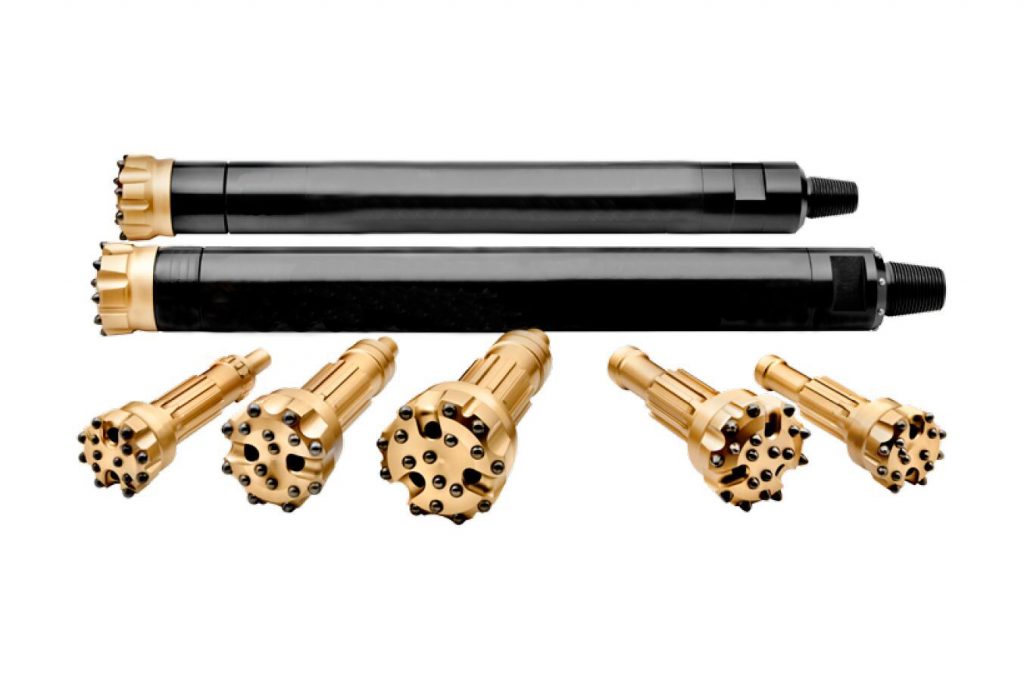2020 官网升级中!现在您访问官网的浏览器设备分辨率宽度低于1280px请使用高分辨率宽度访问。
The DTH drilling tool is a kind of rock drilling equipment that uses compressed air as the power source, submerges the rock drilling impact power part into the rock drilling hole, controls the piston for round-trip motion through the air distribution device of the DTH hammer, impacts the DTH drill bit configured in the front of the hammer, and transfers the impact energy to the drill bit, which will break the rock.
The application fields of DTH drilling tools involve geological and mineral exploration, open-pit mining, construction engineering excavation, water conservancy, and hydropower engineering, cement building materials, mining and quarrying, traffic engineering construction, rock anchoring engineering, underground metal mining and urban water supply, municipal, transportation, environment, and other construction projects. Compared with the top hammer drilling tools, the DTH drilling tools have a series of characteristics such as drilling deep and long holes, large hole diameters, relatively high working efficiency, and a wide application range. Therefore, in the drill and blast method of rock drilling construction, DTH drilling tools play a very important role. And we can improve our products by further understanding and mastering the development trend of DTH drilling tools and their product types in the international market.
The world’s two largest rock drilling tool manufacturers are Sweden’s Atlas Copco and Sandvik, and their product research and development efforts have always been in a leading position in the field of rock drilling equipment. So is there any relationship between them?
Atlas and Sandvik ‘s relationship
Sandvik, the world’s leading manufacturer of rock drilling tools, had a long relationship with Atlas, the world’s leading manufacturer of rock drilling machinery. During the period of rapid development of rock drilling machinery and drilling tools from the 1950s to the 1980s, the rock drilling tools produced by Sandvik have been sold in the market together with the rock drilling machinery manufactured by Atlas. Until 1989, when Atlas acquired Secoroc, a Swedish company specializing in rock drilling tools, and formed its rock drilling tool production enterprise, the cooperation between the two companies was completely interrupted. The following year, Sandvik acquired the Tam-rock mining machinery and equipment in Tampere, Finland, and established its own rock drilling machinery and mining shoveling machinery manufacturing enterprise. Since then, the two former partners have become competitors in today’s rock drilling machinery and drilling tools market.
As far as the production of rock drilling tools is concerned, Sandvik has certain advantages in the development and manufacture of top hammer drilling tools. However, Atlas has its characteristics in DTH and roller cone drilling tools. As the two major manufacturers of rock drilling tools in the international market, Atlas and Sandvik have been competing with each other and constantly launching their new products to the market, especially in the two product areas of hydraulic drilling tools and high-pressure hammers and bits for DTH drilling vehicles, which are in high demand in the market.
DTH drilling tools from Atlas and Sandvik

Among the rock drilling tools produced by Atlas Copco, high-pressure DTH drilling tools account for a large proportion. Therefore, the company has been paying great attention to the research and development of its DTH drilling tools. For example, the COP66 DTH drilling tool launched to the market at the end of 2013 has a short length and is lightweight compared with the previous traditional DTH hammer, and there is no tail exhaust pipe and no central flushing hole in the DTH drill bit.
At the same time as the COP66 DTH drilling tool, Sandvik launched the RH460 DTH hammer. Since the piston is the critical component of the hammer, its structural shape, impact state, and performance are directly related to the performance and service life of the hammer. Compared with the piston of the conventional hammer, it has the advantage of reducing fuel costs while maximizing productivity.